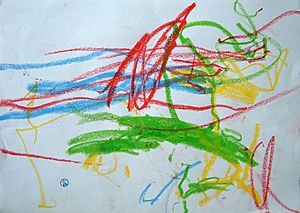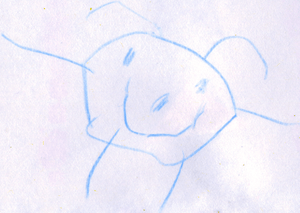Child art facts for kids
Child art is a term created by Franz Cižek in the 1890s. It describes drawings, paintings, or other artworks made by children. A child's art shows how much they understand themselves and how they connect with the world around them.
Contents
What is Child Art?
The idea of "child art" was first used by Franz Cižek (1865–1946) in the 1890s. It refers to the creative works that children make. Sometimes, "child art" can also mean art made by grown-up artists that shows children in their work. It can also mean art made for children, like pictures in a children's book.
A Look Back at Child Art
Many thinkers helped us understand why art is important for children. These include Jean-Jacques Rousseau (1712–78) and Johann Pestalozzi (1746–1827).
In 1884, experts talked about art education for children at a meeting in London. They discussed how to help children develop their artistic skills. Ebenezer Cooke (1837–1913) believed that if children drew what they liked, they would create amazing art. He said it could be like early art from history.
The first art show of children's drawings in Europe was in London in 1890. It was put together by Robert Ablett (1848–1945). An Italian art historian named Corrado Ricci (1858–1934) collected 1250 children's drawings and sculptures.
Franz Cižek really admired children's art. He thought it was special because it wasn't changed by adult ideas. He called a child's drawing "a marvelous and precious document."
In 1897, Cižek started the Juvenile Art Class. This was a free weekend school for children aged 2 to 14. He wanted children to create art freely, without strict rules. Cižek said he learned from the children, rather than just teaching them.
Psychologists also became interested in children's art. They studied how children's drawings changed as they grew. Some famous psychologists who studied this include Georg Kerschensteiner and Georges Rouma.
How Child Art Changes as Kids Grow
As children get older, their art goes through different stages. Ebenezer Cooke first described four of these stages.
Today, these stages are generally known as:
Scribbling Stage

Around their first birthday, children learn to hold a crayon. At first, they just make random marks, called scribbles. They might move their hand left and right, then up and down, and later in circles. Children often enjoy watching the lines and colours appear. They might even draw on their hands or faces!
Around age two, children start to control their scribbles more. They make simple shapes like circles, crosses, and star-bursts. They also like to arrange things, like making collages with paper or patterns with stones. Once they can control their scribbles, they start to give them names.
Pre-Symbolism Stage
Around age three, children begin to combine circles and lines to make simple figures. At first, people might be drawn without a body. Their arms might come right out of their head. Eyes are often very big, and hands and feet are usually missing. At this stage, you might need the child to explain what their drawing is.
Later drawings in this stage show figures floating in space. Their size might show how important the child thinks they are. Most children at this age are not trying to draw things exactly as they look.
Symbolism Stage
In this stage, which starts around age five, children create their own set of images. For example, if a child draws a cat, they will always draw the same basic cat shape. They might add details like stripes or dots. These basic shapes are called symbols or "schema."
Each child develops their own unique symbols. These are based on what the child understands about the object, not just what they see. By this age, most children draw people with a head, body, and limbs that are somewhat in proportion.
Before this stage, objects in drawings seemed to float. But around age five or six, children start to use a baseline. This is often a green line at the bottom of the paper, representing grass. The figures stand on this line. Older children might add more baselines for background objects and a skyline for the sun and clouds.
At this stage, cultural influences become more important. Children draw from real life, but they also copy images around them, like cartoons. They also start to understand how to tell a story with their pictures. They might learn about perspective by copying other drawings.
Realism Stage
As children get older, they find their simple symbols limiting. They realize their drawings of people don't look like real people. This stage starts around age nine or ten. Children now care more about whether their drawing looks like the real object.
This can be a difficult time for some children. Their desire to draw well might be greater than their current skills. Some children might even stop drawing. However, others become very skilled. This is when formal art training can help a child the most. The baseline is no longer needed, and children can learn rules like perspective to draw space better. Storytelling in art also improves, and children might start drawing comic strips.
Art for Healing
Art therapy can help children understand and express their feelings. Some children with autism find that drawing helps them show emotions they can't easily talk about. Children who have experienced difficult events, like war, might find it hard to speak about them directly. Art can help these children deal with their emotions.
Thinking About Child Art
After seeing a children's art show in the 1980s, educator John Holt said that much of what we call "children's art" is actually ideas from adults. He believed that adults often put their own ideas onto children's art.
Is Child Art Reliable?
Experts sometimes debate how reliable children's art is as proof of their experiences. In recent years, courts around the world have started to accept children's art as evidence. For example, in 2004, the International Criminal Court accepted about 500 children's drawings. These drawings were used as evidence in investigations of crimes during the War in Darfur.
Child Art as History
Children's art is also valuable for historians. It helps them understand what life was like for children in the past. Sometimes, children's art can show their experiences directly. In 1945, the Swiss Red Cross asked children freed from Auschwitz to draw pictures. Historian Nicholas Stargardt used some of these drawings to understand what Jewish children went through in concentration camps.
Historian Jack Hodgson says that children's art will always have some mystery because we need to interpret it. But he believes it has "enormous communicative potential," especially for showing feelings or emotions that are hard to put into words.
Images for kids
See also
 In Spanish: Arte infantil para niños
In Spanish: Arte infantil para niños






